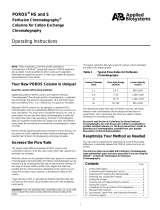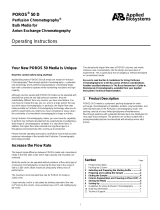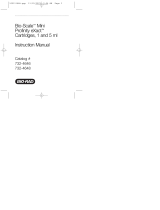Page is loading ...

Operating Instructions
1
1 Product Description
POROS® Affinity Depletion Cartridges and columns are available in
two affinity chemistries:
•POROS Anti-HSA Cartridges – Packed with POROS
Perfusion Chromatography media covalently coupled with an
affinity-purified goat polyclonal antibody against human serum
albumin (HSA).
•POROS Protein G Cartridges – Packed with POROS
Perfusion Chromatography media covalently coupled with
recombinant Protein G.
POROS® Affinity Depletion Cartridges can be operated:
• Singly or in tandem with a cartridge of a different chemistry.
• Manually or on an automated MDLC (multi-dimensional liquid
chromatography) workstation (for example, Applied
Biosystems VISION™ or BioCAD workstations).
Table 1 Product Characteristics
Support Matrix Cross-linked poly(styrene-divinylbenzene)
Immobilized Ligand • POROS Anti-HSA – Affinity-purified
goat anti-HSA polyclonal antibody
•POROS G – Recombinant protein G
Saturation Capacity
@ 500 cm/hr •POROS Anti-HSA – 2 mg/mL. For
complete removal of HSA in serum
samples, do not exceed 50% of the
saturation capacity. For more
information, see the Sample Volume
ranges listed on page 3.
•POROS G – 15 mg/mL. For complete
removal of IgG, do not exceed 50% of
the saturation capacity. When used in
tandem with a POROS Anti-HSA
cartridge, do not exceed the Anti-HSA
cartridge capacity.
Shipping Solvent 0.1 M phosphate buffer pH 7.0,
0.05% sodium azide
Shrinkage/Swelling <1% from 1 to 100% solvent
Cartridge Dimensions 4 mmD × 15 mmL (0.2 mL)
6.2 mmD × 66.5 mmL (2.0 mL)
7.5mmD × 100 mmL (4.4 mL)
Table 2 Chemical Resistance
pH Range • POROS Anti-HSA – 2 to 10
•POROS G – 2 to 9
Ionic Strength Range 0 to 5 M, all common salts
Buffer Additives • POROS Anti-HSA – Agents that may
degrade the protein ligands are not
recommended.
•POROS G – All common agents,
including 4 M urea, 2 M guanidine
hydrochloride, ethylene glycol, and
detergents. Agents that may degrade
the protein ligands are not
recommended.
Solvents Water, 0 to 30% alcohols, acetonitrile,
other common organic solvents.
NOTE: Do not expose to strong oxidizers
(such as hypochlorite), oxidizing acids
(such as nitric acid), or strong reducing
agents (such as sulfite).
Operating
Temperature 5 to 40 °C
Contents Page
1 Product Description........................................................1
2 Connecting the Cartridge ...............................................2
3 Buffers............................................................................2
4 Preparing the Anti-HSA Cartridge..................................2
5 Cartridge Operating Conditions......................................3
6 Running a Cleanup Method ...........................................4
7 Storing the Cartridge......................................................5
8 Accessories, Spare Parts, and Ordering Information.....5
9 Technical Support...........................................................5
POROS® Affinity Depletion
Cartridges

2
2 Connecting the Cartridge
POROS Affinity Depletion Cartridges can be used singly or in tandem
with a second cartridge of different chemistry.
2.1 Single-Cartridge Connection
Figure 1 illustrates connections of a single cartridge for manual use.
For use with an automated MDLC workstation (for example, Applied
Biosystems VISION™ or BioCAD workstations), plumb the cartridge
inlet using standard 10/32 HPLC fittings (PEEK or stainless steel).
Figure 1 Cartridge Connection for Manual Use
2.2 Tandem-Cartridge Connection
For tandem-cartridge connection, connect a 5-cm piece of blue PEEK
tubing (1/16-inch O.D., 0.010-inch I.D.) between cartridges using
standard 10/32 HPLC fittings.
3Buffers
In general, when you prepare buffers:
• Use buffers of the highest purity practical.
• Degas and filter (0.22 or 0.45 µm) all buffers before use.
Prepare the following buffers.
4 Preparing the Anti-HSA Cartridge
Before injecting human serum for the first time on the Anti-HSA
cartridge, perform one blank run (no sample) that includes the
following steps:
• 5 cartridge-volume equilibration step
• 5 cartridge-volume elution step
• 5 cartridge-volume clean step
• 5 cartridge-volume equilibration step
The Equilibration step followed by the Elution step removes any weakly
bound antibody from the cartridge and increases the run-to-run
reproducibility.
Syringe
Needle-port
adapter
Cartridge holder
with cartridge
Compression screw
1/16-inch O.D. PEEK
outlet tubing
Syringe needle
Buffer Composition
Equilibration, Load,
and Wash Phosphate buffered saline (PBS), pH 7.2
Elution 12 mM HCl
CHEMICAL HAZARD.
Hydrochloric acid (HCl) causes severe
eye, skin, and respiratory tract burns.
Read the MSDS, and follow the handling
instructions. Wear appropriate protective
eyewear, clothing, and gloves.
Cleaning • Anti-HSA – 1 M NaCl
•Protein G – 2 M urea in 1 M NaCl or
10% acetic acid in 1 M NaCl
CHEMICAL HAZARD.
Read the MSDS, and follow the handling
instructions. Wear appropriate protective
eyewear, clothing, and gloves.
Urea may cause eye, skin and respiratory
tract irritation.
10% acetic acid in 1 M sodium chloride
is a flammable liquid and vapor. Exposure
causes eye, skin, and respiratory tract
burns. It may be harmful if inhaled,
swallowed, or absorbed through the skin.
Keep away from sparks, heat, and flame.
DANGER
!
CAUTION
!

3
5 Cartridge Operating Conditions
BIOHAZARD. Biological samples such as tissues, body fluids, and blood of humans and other animals have the potential to
transmit infectious diseases. Read and follow the guidelines published in Biosafety in Microbiological and Biomedical Laboratories
(http://bmbl.od.nih.gov) and in the Occupational Safety and Health Standards, Bloodborne pathogens (http://www.access.gpo.gov/nara/cfr/
waisidx_01/ 29cfr1910a_01.htm). Follow all applicable local, state/provincial, and/or national regulations. Wear appropriate protective eyewear,
clothing, and gloves.
Step/Buffer Condition Settings
0.2-mL Cartridge 2.0-mL Cartridge 4.4 mL-Cartridge
Equilibration
PBS, pH 7.2 Flow Rate
(5 to 10 cartridge volumes) 1 mL/min 2.4 mL/min 3.5 mL/min
Load – Anti-HSA
PBS, pH 7.2 Note: The concentration of albumin in diluted human serum is 3 to 7 mg/mL. Adjust sample volume to accommodate the
albumin concentration in your sample. For example, if the albumin concentration in your 10% diluted human serum sample
is ~3 mg/mL, you can load up to the maximum of 70 µL. If the albumin concentration in your sample is ~7 mg/mL, load a
lower sample volume of 30 µL.
Sample Volume
(10% diluted human serum with PBS) 30 to 70 µL 300 to 700 µL 600 to 1,600 µL
Flow Rate 0.5 mL/min 1.2 mL/min 1.8 mL/min
Comment Capture the Load step effluent in up to five 0.5-CV fractions. Determine which
fractions contain protein (measure by UV absorbance at 280 nm), then pool the
protein-containing fractions for further proteomics analysis.
If breakthrough of albumin occurs, it may be because the concentration of
albumin in the sample exceeds the cartridge capacity. Repeat the run and use a
smaller injection volume.
Load – Protein G
PBS, pH 7.2 Note: The concentration of IgG in diluted human serum is 0.8 to 1.8 mg/mL. Adjust sample volume to accommodate the
IgG concentration in your sample. For example, if the IgG concentration in your 10% diluted human serum sample is
~0.8 mg/mL, you can load up to the maximum of 2 mL. If the IgG concentration in your sample is ~1.8 mg/mL, load a lower
sample volume of 1 mL.
Sample Volume
(10% diluted human serum with PBS) 1 to 2 mL 20 to 10 mL N/A
Flow Rate 0.5 mL/min 1.2 mL/min N/A
Comment Capture the Load step effluent in up to five 0.5-CV fractions. Determine which
fractions contain protein (measure by UV absorbance at 280 nm), then pool the
protein-containing fractions for further proteomics analysis.
Wash
PBS, pH 7.2 Flow Rate
(15 to 30 cartridge volumes) 1 mL/min 2.4 mL/min 3.5 mL/min
Elution
12 mM HCl Flow Rate
(5 to 10 cartridge volumes) 1 mL/min 2.4 mL/min 3.5 mL/min
Comment For optimum performance, run an Elution step during each cycle to remove the
bound serum proteins and prepare the cartridge for the next cycle.
Cleaning
•Anti-HSA –
1 M NaCl
•Protein G –
2 M urea in 1 M
NaCl or 10%
acetic acid in
1 M NaCl
Flow Rate
(5 to 10 cartridge volumes) 1 mL/min 2.4 mL/min 3.5 mL/min
Comment Perform a Cleaning step after 1 to 2 cycles to reduce fouling that may decrease
cartridge performance.
WARNING!

4
6 Running a Cleanup Method
In some applications, or after many cycles, sample molecules may not
fully elute or may precipitate on the cartridge and cause any of the
following symptoms:
• Increased bandspreading
• Loss of binding capacity
• Loss of recovery
• Increased pressure drop
• Trace or “ghost” peaks different from the usual RI (refractive
index) shift peak during blank runs
Clean the cartridge if any of the symptoms listed above appear.
NOTE: In any cleanup method, reversing the flow direction is
recommended to help flush out particulates and to prevent
contamination of the lower part of the bed. Also, to expose the
cartridge to the regeneration solution for several minutes at each step
of the cleaning protocol, slowing the flow rate is recommended.
Recommended Cleaning Solutions
CHEMICAL HAZARD. Urea may cause eye, skin
and respiratory tract irritation. Read the MSDS, and follow the handling
instructions. Wear appropriate protective eyewear, clothing, and
gloves.
CHEMICAL HAZARD. 10% acetic acid in 1 M
sodium chloride is a flammable liquid and vapor. Exposure causes
eye, skin, and respiratory tract burns. It may be harmful if inhaled,
swallowed, or absorbed through the skin. Keep away from sparks,
heat, and flame. Read the MSDS, and follow the handling instructions.
Wear appropriate protective eyewear, clothing, and gloves.
Cleaning by Pumping
To clean the cartridge, follow these guidelines:
1. Wash with 15 to 30 column volumes of the solution recommended
for your cartridge to remove contaminants.
2. For Protein G cartridges only, you can remove precipitated protein,
bound lipids, and so on, by other means, for example:
• Brief washes with alcohols, acetonitrile, or mixtures of these
solvents with 20% acetic acid
• 2 M guanidine hydrochloride
CHEMICAL HAZARD. Acetonitrile (ACN) is a
flammable liquid and vapor. Exposure may cause eye, skin, and
respiratory tract irritation, central nervous system depression, and
damage to the heart, blood system, liver, and kidneys. Read the
MSDS, and follow the handling instructions. Wear appropriate
protective eyewear, clothing, and gloves.
Cartridge Cleaning Solution
Anti-HSA 1 M NaCl
Protein G 2 M urea in 1 M NaCl
10% acetic acid in 1 M NaCl
CAUTION
!
DANGER
!
WARNING!
CHEMICAL HAZARD. 20% Acetic acid is a
flammable liquid and vapor. Exposure causes eye, skin, and
respiratory tract burns. It may be harmful if inhaled, swallowed, or
absorbed through the skin. Keep away from sparks, heat, and
flame. Read the MSDS, and follow the handling instructions. Wear
appropriate protective eyewear, clothing, and gloves.
CHEMICAL HAZARD. Guanidine
hydrochloride may be harmful if swallowed or absorbed through
the skin. Exposure may cause eye, skin, and respiratory tract
irritation and adverse effects on the central nervous system and
bone marrow. Read the MSDS, and follow the handling
instructions. Wear appropriate protective eyewear, clothing, and
gloves.
Cleaning by Making Multiple Injections
For very aggressive or very viscous solvents, use multiple injections of
cleaning solutions instead of pumping cleaning solutions directly.
To clean by injections:
• Make the injection volume as large as possible.
• Use a low flow rate to expose the cartridge to the cleaning
solution for several minutes.
DANGER
!
WARNING
!

5
7 Storing the Cartridge
When you store your cartridge, always be sure to:
• Store cartridges in the refrigerator. DO NOT FREEZE
CARTRIDGES!
• Store the cartridge with the endcaps in place, carefully sealed
to prevent drying. Drying results in decreased chromatographic
efficiency.
Short-Term Storage (less than 1 day)
1. Equilibrate the cartridge in PBS.
2. Remove the cartridge from the cartridge holder and insert end caps
to prevent the cartridge from drying out.
3. Store cartridges at 4 °C.
Long-Term Storage (more than 1 day)
1. Equilibrate the cartridge in PBS with 0.05% sodium azide.
Sodium azide may react with lead and copper
plumbing to form highly explosive metal azides. If disposing of
solutions that contain sodium azide down laboratory sinks, flush
the drains with large volumes of water to prevent azide buildup.
2. Remove the cartridge from the cartridge holder and insert end caps
to prevent the cartridge from drying out.
3. Store at 4 °C.
8 Accessories, Spare Parts, and Ordering
Information
Available accessories for your POROS® Affinity Depletion cartridges
are listed below:
9 Technical Support
Applied Biosystems is dedicated to helping you use POROS Affinity
Depletion Cartridges to the fullest extent possible.
Applied Biosystems publishes a continuing series of Proteomics
Application and Technical Notes. Please contact Applied Biosystems
directly for a publication list.
For further details or for answers to questions on POROS Affinity
Depletion cartridges, Perfusion Chromatography, or other products,
please contact Applied Biosystems. Refer to the back page of this
document for contact information.
WARNING
!
Table 3 Affinity Cartridge Accessories
Description Quantity Part
Number
POROS Affinity Depletion
Anti-HSA Cartridge ___ ___
4 mmD × 15 mmL (0.2 mL) 1 4337325
6.2 mmD × 66.5 mmL (2.0 mL) 1 4337344
7.5mmD × 100 mmL (4.4 mL) 1 4337345
POROS Affinity Depletion
Protein G Cartridge ___ ___
4 mmD × 15 mmL (0.2 mL) 1 4337331
6.2 mmD × 66.5 mmL (2.0 mL) 1 4337347
Cartridge Holder ___ ___
0.2 mL 1 4326688
2.0 mL 1 4337843
Needle-Port Adapter 1 4326689
Outlet Connector 1 4326690

Headquarters
850 Lincoln Centre Drive
Foster City, CA 94404 USA
Phone: +1 650.638.5800
Toll F re e (I n N or th A me ri ca ): +1 8 00 .3 45 .5 22 4
Fax: +1 650.638.5884
Worldwide Sales Offices
Applied Biosystems vast distribution and service
network, composed of highly trained support and
applications personnel, reaches 150 countries on six
continents. For international office locations, please
call our headquarters or see our Web site at
www.appliedbiosystems.com.
Technical Support
In North America, call +1 800.899.5858.
Outside North America, see our Web site at
www.appliedbiosystems.com, or call our local sales
office.
www.appliedbiosystems.com
Applied Biosystems is committed to providing
the world’s leading technology and information
for life scientists.
Printed in the USA, 04/2011
Part Number 4333109 Rev. B
©Copyright 2002, 2011 Applied Biosystems. All rights reserved.
For Research Use Only. Not for use in diagnostic procedures.
Information in this document is subject to change without notice.
Applied Biosystems assumes no responsibility for any errors that
may appear in this document. This document is believed to be
complete and accurate at the time of publication. In no event shall
Applied Biosystems be liable for incidental, special, multiple, or
consequential damages in connection with or arising from the use of
this document.
Applied Biosystems, BioCAD, Perfusion Chromatography, and
POROS, are registered trademarks of Applied Biosystems or its
subsidiaries in the U.S. and certain other countries.
AB (Design), Applera, and VISION are trademarks of Applied
Biosystems or its subsidiaries in the U.S. and certain other coun-
tries.
PEEK is a trademark of Victrex, PLC.
All other trademarks are the sole property of their respective owners.
/










